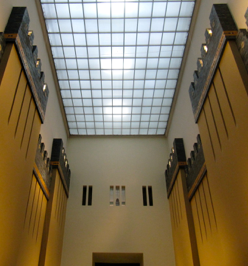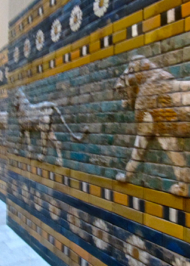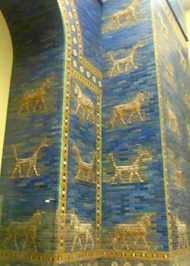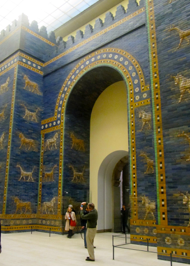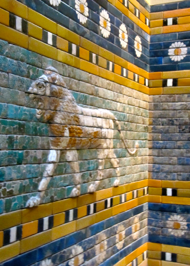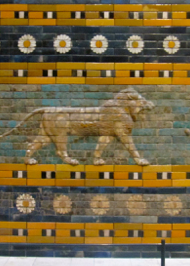Ishtar gate
PERGAMON MUSEUM
Museum Island
Berlin, brandenburg
eastern Germany
europe
October 7 - 15, 2011


Ishtar gate
PERGAMON MUSEUM
Museum Island
Berlin, brandenburg
eastern Germany
europe
October 7 - 15, 2011


The Ishtar Gate was the eighth gate to the inner city of Babylon. It was built on the north side of the city in 575 BC under the orders of King Nebuchadnezzar II. The gate was dedicated to the Babylonian goddess Ishtar*. The gate, reconstructed from material excavated between 1902-1914, was then rebuilt in the Pergamon Museum, completed in 1930. The original gate was a double gate, considered to be one of the Seven Wonders of the World, until the 6th century AD when it was replaced by the Lighthouse of Alexandria. The gate, installed in the museum, measures 47 feet/14 meters in height and 100 feet/30 meters in width. It is the smaller frontal part of the original, as the larger part was considered to be too large to fit within the museum. The roof and the door of the gate were made of cedar, according to a dedication plaque. The walls of which were covered with glazed bricks. Horizontal, geometric motifs and flowers separated the bas relief figures of dragons, lions, and aurochs, while 120 lions decorated the long Processional Way. Many of these figures, principally the lions, have been placed in several museums around the world including the following museums in the USA:
The Detroit Institute of Arts (a dragon)
The University of Pennsylvania Museum of Archaeology and Anthropology
in Philadelphia
The Metropolitan Museum of Art in New York City
The Oriental institute in Chicago
The Rhode Island School of Design Museum in Providence, Rhode Island
The Yale University Art Gallery in New Haven, Connecticut
The Museum of Fine Arts in Boston
*Ishtar was the goddess of love and war. Associated with sexuality, her cult involved sacred prostitution. Her city, the holy city of Uruk, was called the “town of sacred courtesans” and she herself was the “courtesan to the gods”. Ishtar had many lovers and treated her lovers cruelly. In a myth where Ishtar desires to descend into the underworld, the queen of the underworld requires Ishtar to shed one article of clothing at each gate. When she finally passes through the seventh gate, she is naked; and, upon her return from the underworld, reclaims each article until she is fully clothed when she ascends to life. Could there be any significance that the Ishtar Gate is the eighth gate into Babylon? In the Babylonian pantheon, Ishtar was the divine personification of the planet Venus. Her symbols were the lion and the eight-pointed star.
PHOTOS: Top Three: 1. View of a portion of the Processional Way with bas relief lions. 2. Detail of the glazed brick covering the wall and gate. 3. View of the arched entrance to Babylon. Middle Three: 1.2. & 3. Three views of the Processional Way. Bottom Three: 1. Exterior of the gate with lion. 2. Detail of the gate with auroch. 3. Detail of the gate with horizontal decorations dividing the dragons, aurochs and lion figures.

Gate of Babylon


